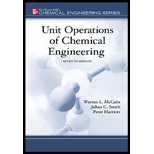
Concept explainers
(a)
Interpretation:
The type of flow at temperature
Concept Introduction :
Reynolds number is the ratio of inertia forces to the viscous forces. It is used to check the type of flow of fluids through pipe and tubes.
The formula of Reynolds number is,
As the temperature is increased from
The variation of viscosity with the temperature is given as:
(b)
Interpretation:
The type of flow on increasing tube size is to be determined.
Concept Introduction :
Reynolds number is the ratio of inertia forces to the viscous forces. It is used to check the type of flow of fluids through pipe and tubes.
The formula of Reynolds number is,
The diameter of the tube is inversely proportional to the square root of velocity.
The relationship between diameter and velocity is given as:
By suing the above relationship, find out the velocity at increased diameter.
(c)
Interpretation:
The type of flow at increased pressure is to be determined.
Concept Introduction :
Reynolds number is the ratio of inertia forces to the viscous forces. It is used to check the type of flow of fluids through pipe and tubes.
The formula of Reynolds number is,
The density of the fluid is affected by the pressure.
The relationship between density and pressure is given as,
On increasing the pressure, the density also increases but the velocity decreases in the same proportion.
Want to see the full answer?
Check out a sample textbook solution
Chapter 3 Solutions
Unit Operations of Chemical Engineering
 Introduction to Chemical Engineering Thermodynami...Chemical EngineeringISBN:9781259696527Author:J.M. Smith Termodinamica en ingenieria quimica, Hendrick C Van Ness, Michael Abbott, Mark SwihartPublisher:McGraw-Hill Education
Introduction to Chemical Engineering Thermodynami...Chemical EngineeringISBN:9781259696527Author:J.M. Smith Termodinamica en ingenieria quimica, Hendrick C Van Ness, Michael Abbott, Mark SwihartPublisher:McGraw-Hill Education Elementary Principles of Chemical Processes, Bind...Chemical EngineeringISBN:9781118431221Author:Richard M. Felder, Ronald W. Rousseau, Lisa G. BullardPublisher:WILEY
Elementary Principles of Chemical Processes, Bind...Chemical EngineeringISBN:9781118431221Author:Richard M. Felder, Ronald W. Rousseau, Lisa G. BullardPublisher:WILEY Elements of Chemical Reaction Engineering (5th Ed...Chemical EngineeringISBN:9780133887518Author:H. Scott FoglerPublisher:Prentice Hall
Elements of Chemical Reaction Engineering (5th Ed...Chemical EngineeringISBN:9780133887518Author:H. Scott FoglerPublisher:Prentice Hall
 Industrial Plastics: Theory and ApplicationsChemical EngineeringISBN:9781285061238Author:Lokensgard, ErikPublisher:Delmar Cengage Learning
Industrial Plastics: Theory and ApplicationsChemical EngineeringISBN:9781285061238Author:Lokensgard, ErikPublisher:Delmar Cengage Learning Unit Operations of Chemical EngineeringChemical EngineeringISBN:9780072848236Author:Warren McCabe, Julian C. Smith, Peter HarriottPublisher:McGraw-Hill Companies, The
Unit Operations of Chemical EngineeringChemical EngineeringISBN:9780072848236Author:Warren McCabe, Julian C. Smith, Peter HarriottPublisher:McGraw-Hill Companies, The





